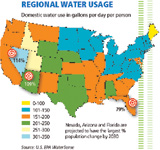By: Bruce R. Fraedrich
Salt (sodium chloride) applied as a deicing agent on streets and sidewalks causes severe damage to many species of roadside and lawn ornamentals. Damage results when salt, dissolved in runoff water, is leached into the root zone or when it comes in contact with foliage and branches in the form of spray created by passing vehicular traffic. Naturally occurring saltwater and heavy applications of low-grade agricultural fertilizers having high salt indices can cause severe injury in the same manner as deicing salts.
Plant sensitivity to salt varies greatly among species and among individuals of the same species. Many ornamentals exhibit a very high degree of tolerance while others, particularly shallow-rooted species and evergreens, are readily injured. Injury depends on the concentration of salt in the soil or on the foliage, and symptoms are usually evident only after salt has accumulated to a toxic level.
Symptoms
Symptoms of salt injury may not always be well-defined and often resemble those caused by other adverse environmental factors, particularly drought or air pollution.
Affected plants commonly exhibit some or all of the following symptoms:
- Delay in leaf budbreak and flowering;
- Stunted foliage and buds;
- Reduced shoot growth;
- Tip or marginal foliage browning;
- Crown thinning and tufting of foliage at branch tips;
- Premature fall coloration and defoliation; and
- Twig mortality.
Crown dieback, invasion by insect borers and weakly pathogenic fungi, and eventually total plant mortality occur in severe instances. Symptoms are most severe on plantings closest to, or on the downward slope from, the salt source. Injury is most pronounced on the side of the plant facing the salt source and on lower branches, particularly evergreens.
Effect on vegetation
Salt is reputed to “burn” or desiccate roots and foliage with which it comes in contact. This results from the natural movement of water or sap from an area of low salt or ionic concentration within plant cells to one of higher concentration in the soil or on foliar surfaces. Injury due to desiccation is particularly severe during dry periods when soil moisture or atmospheric humidity is limited.
Other pathogenic roles of salt have been suggested, but further study is needed for confirmation. Recent research indicates that sodium and/or chloride ions themselves may be toxic to plants in quantity. The former element particularly is suspect since, unlike chlorides, which are highly mobile and readily translocated to the leaves where they are shed; sodium is extremely static and will accumulate in soil and plant tissue. High sodium concentration in plant tissues may alter a plant’s mineral nutrition balance and inhibit protein synthesis.
Treatments
Resistant Species: In areas subject to deicing salts or natural salt spray, injury can be minimized by proper initial selection of planting stock. A partial listing of commonly planted, resistant species is included on the attached page. State extension services or the Bartlett Tree Research Laboratories can provide a more complete listing for a given area.
Cultural Practices: Calcium chloride, an effective deicing agent which is much less toxic to plants, should be substituted for sodium chloride on pavements around ornamentals whenever possible. Large scale use of calcium chloride, however, is prohibitive due to its higher cost and difficulty in application and storage. Other materials including sand and urea are valid, but less effective, substitutes for sodium chloride.
Diverting runoff from salted pavements away from existing plantings is helpful in preventing salt injury. Similarly, protective barriers of burlap, polyethylene, wood, etc. will help prevent salt spray from coming into contact with foliage and branches.
Anti-desiccants reportedly act as a barrier to salt spray; however, results thus far have been extremely variable and inconclusive.
Recognized cultural practices including fertilization, mulching, watering heavily during dry periods and thinning the crown to a level in balance with the ability of the root system to support it will help alleviate salt injury. Care should be taken to select only those fertilizers with low salt indices, which are suitable for ornamentals. The Bartlett Tree Research Laboratories’ Technical Report CP-1.3 outlines requirements for tree and shrub fertilizers.
Gypsum: Gypsum (calcium sulfate), a naturally occurring compound native to the Southwestern United States, has long been used in agriculture as a source of calcium and sulfur and as an amendment to improve soil structure. Recently, gypsum has been found to counteract salt injury by reacting with toxic sodium ions present in soil and rendering them unavailable to the plant. The negatively charged sulfate ions in gypsum bond with the positively charged sodium ions to form sodium sulfate, a highly soluble salt that is readily leached from soil. The remaining positively charged calcium ions are free to bond with negatively charged clay molecules, thereby acting as a “binding agent” between soil particles and resulting in increased soil permeability and aeration.
Gypsum can be surface-applied with a lawn spreader or applied via deep placement in the same manner as granular fertilizers. Recommended rates vary between 20 and 40 lbs. per 100 sq. ft. of soil surface, depending upon salt content and soil texture. Gypsum is commercially available from many farm and garden centers.
— The author is a Plant Pathologist with Bartlett Trees Experts and heads up its Research Laboratory and Arboretum in Charlotte, NC. For more information visit www.bartlett.com.

